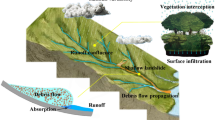Abstract
An important problem in sedimentation analysis is the development of a channel section that preserves, as best as possible, the current sedimentation regime even though the flood frequency tendencies have been altered due to land development within the catchment. In order to accomplish this task, a methodology is needed that estimates sediment transport capacity for various channel configurations. Such a procedure is described which allows the computation of the total sediment transport capacity for each of several T-year return frequency runoff hydrographs. This information is used to obtain an approximate probability distribution for the total sediment transport capacity, and the mean and standard deviation of this distribution are computed.
Comparing the results for the catchment in its present state with a future developed state, using a selection of new channel parameters, indicates how to improve the channel to control changes in sedimentation due to development. The analysis procedure provides a basis for estimating a new channel configuration such that the new flow conditions retain, as best as possible, the existing condition sedimentation effects, and hence retain the natural sediment supply and transport trends even though runoff flow rates have changed due to land development within the catchment.
The results of Wilson Creek are typical of the several sites examined, see Table 3 below. The T=2, T=5, T=25, and T=100 year values for total sediment transport capacity, in kilotons, are 6.9, 39.4, 61.3, and 96.7 with a mean of 17.1 and standard deviation of 19.3. After development with no change in the channel the respective values increase to: 17.9, 84.6, 128.1, and 258.0 with a mean of 39.1 and standard deviation of 44.3. A new channel can be constructed which will reduce these sediment transport capacity values, after development, to 5.2, 41.0, 62.0, and 124.8 with a mean of 17.4 and standard deviation of 22.0.
Similar content being viewed by others
References
Boyle Engineering Corporation 1992: Master plan of drainage for city of Yucaipa
Brownlie, W. 1982: Prediction of flow depth and sediment discharge in open channels. Ph.D. thesis, California Institute of Technology, Pasadena, California
Henderson, F. 1966: Open channel flow. New York: MacMillan
Hromadka II, T.; Whitley, R. (1989): Stochastic integral equations and rainfall runoff models. Springer-Verlag, New York
Rivertech, Inc. 1989: Yucaipa Valley Acres Regional Drainage Plan, January, 1989
Author information
Authors and Affiliations
Rights and permissions
About this article
Cite this article
Hromadka, T.V., Whitely, R.J. Evaluating the effect of land development on sediment transport using a probability density function. Stochastic Hydrol Hydraul 7, 102–108 (1993). https://doi.org/10.1007/BF01581419
Issue Date:
DOI: https://doi.org/10.1007/BF01581419




